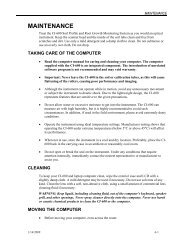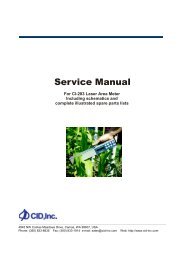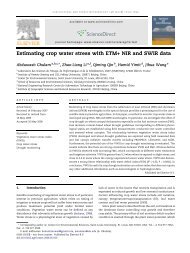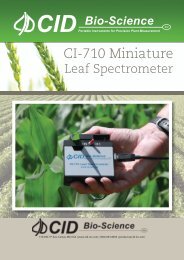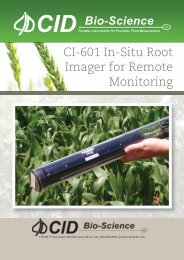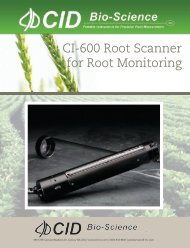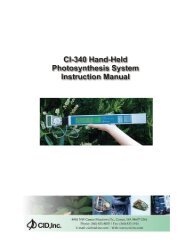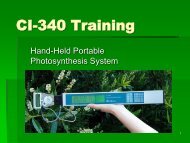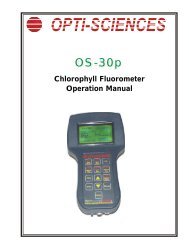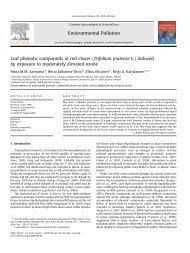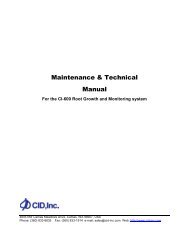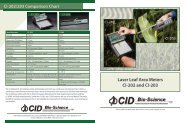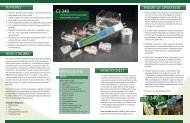Nanoporous Gold Electrocatalysis for Ethylene Monitoring ... - CID, Inc.
Nanoporous Gold Electrocatalysis for Ethylene Monitoring ... - CID, Inc.
Nanoporous Gold Electrocatalysis for Ethylene Monitoring ... - CID, Inc.
Create successful ePaper yourself
Turn your PDF publications into a flip-book with our unique Google optimized e-Paper software.
176 Shekarriz and L. Allen: <strong>Nanoporous</strong> <strong>Gold</strong> <strong>Electrocatalysis</strong> <strong>for</strong> <strong>Ethylene</strong> <strong>Monitoring</strong><br />
tassium permanganate scrubber <strong>for</strong> 35 s, a total of<br />
1.083 min cycle. This process continued <strong>for</strong> over 100 min<br />
and a data point was taken after each cycle. By injecting a<br />
10,000 ppm gas sample into the container, the initial concentration<br />
was brought up to approximately 1 ppm and<br />
was allowed to be scrubbed out while monitoring this process<br />
with the sensor. This is evident in the slope of the two<br />
curves. While the time constant <strong>for</strong> the electrocatalytic<br />
scrubbing was linked to Equation (3), the potassium permanganate<br />
scrubber time constant, which is approximately<br />
34 min, was related to the ratio of container volume<br />
(4 L) to the flow rate of air directed through the scrubber<br />
during each cycle (200 ml min –1 <strong>for</strong> 35 s). Clearly, the<br />
electrocatalytic depletion rate is roughly 10 % of that <strong>for</strong><br />
potassium permanganate scrubber, which is 100 %.<br />
Application in Apple and Pear Chamber Measurements<br />
Tests were per<strong>for</strong>med with various apples and pears kept in<br />
RA and CA chambers. These tests were carried out in collaboration<br />
with Dr. Jinhe Bai at the Oregon State University<br />
Experiment Station in Hood River, Oregon and Dr. Jim Mattheis<br />
at USDA-ARS in Wenatchee, Washington. For testing<br />
of pears, 18 different RA chambers were each filled with 10<br />
pears. The air from each chamber was recirculated through<br />
our sensor while a small sample was simultaneously run<br />
through a GC. The data was then plotted <strong>for</strong> comparison as<br />
shown in Fig. 9. The very low ethylene producing pears<br />
were treated with 1-methylcyclopropene, which is an ethylene<br />
blocker. The agreement is quite good even at very<br />
low concentrations of significantly smaller than 0.5 ppm.<br />
Another set of tests were per<strong>for</strong>med <strong>for</strong> measuring the<br />
rate of ethylene production, which appears to be an important<br />
parameter <strong>for</strong> postharvest fruit quality characterization.<br />
By measuring the rate of ethylene production <strong>for</strong><br />
various apples, one can determine the physiological maturity<br />
of fruit. This “real-time” in<strong>for</strong>mation permits the<br />
grower to make instant decisions regarding timing the<br />
harvest as well as deciding on whether or not the fruit is<br />
storable or needs to be sold quickly. In these experiments,<br />
after placing a single apple in a sealed jar, the jar was connected<br />
to the sensor to measure the rate of ethylene build<br />
up inside the jar. Fig. 10 shows the results of our measurements<br />
<strong>for</strong> two different types of ‘Fuji’ apples, namely, organic<br />
vs. conventional. The results produce a very unambiguous<br />
measure of the ethylene production rate in each<br />
case, by simply using the slope of the curve at any point<br />
as a measure of the ethylene production rate.<br />
Conclusions<br />
In this paper, a new electrocatalytic sensor was presented<br />
where both sensitivity and response time was shown to be<br />
significantly better than standard diffusion-type electrochemical<br />
sensors. The oxidation reaction of the ethylene<br />
molecules on the surface of the nanoporous catalyst was<br />
shown to take place quite efficiently, typically between 0.1<br />
and 0.2 µmol h –1 cm –2 . This high reactivity yields response<br />
time of better than 10 s and a sensitivity that provides the capability<br />
to measure ethylene down to 10 ppb using the current<br />
electrocatalyst configuration. Future developments<br />
could potentially provide even higher sensitivity and possibly<br />
better response times than those reported in this paper.<br />
The linearity of the sensor response provides a simple calibration<br />
operation that only requires a single point calibration<br />
at the expected range of measurement. The utility and<br />
use of this device was shown <strong>for</strong> monitoring ethylene levels<br />
during pear storage, monitoring scrubbing of ethylene in<br />
storage, and <strong>for</strong> determining the ethylene production rate of<br />
apples (or other fruit) as needed <strong>for</strong> quality control in postharvest<br />
processes.<br />
Acknowledgements<br />
Financial contribution was made by the Small Business<br />
Innovation Research program of the US Department of<br />
Agriculture under two grants: 2004-33610-14425 and<br />
2005-33610-16464. Financial assistance was also provided<br />
by the Washington Tree Fruit Research Commission,<br />
and the Pacific Northwest National Laboratory (PNNL).<br />
The author would like to acknowledge the technical support<br />
from Dr. Larry Pederson from PNNL and Dr. Jinhe<br />
Bai from OSU Experiment Station <strong>for</strong> their support in this<br />
project. The authors would also like to thank Dr. Michael<br />
Blanke from the University of Bonn and Dr. Ralph Gäbler<br />
from Invivo, GmbH <strong>for</strong> their constructive comments and<br />
<strong>for</strong> testing the beta prototypes.<br />
References<br />
ARPAIA, M.L., F.G. MITCHELL, A.A. KADER and G. MAYER 1985:<br />
Effects of 2 % O 2 and varying concentrations of CO 2 with<br />
or without C 2 H 4 on the storage per<strong>for</strong>mance of kiwifruit.<br />
Amer. J. Hort. Sci. 110, 200–203.<br />
ASTRUC, D., F. LU and J. R. ARANZAES 2005: Nanoparticles as<br />
recyclable catalysts: The Frontier between Homogeneous<br />
and Heterogeneous Catalysis. Angew. Chem. Int. Ed. 44,<br />
7852–7872.<br />
BLANKE, M. 2008: A Portable High Resolution <strong>Ethylene</strong> Detector<br />
Based on New Sensor Technology. Erwerbs-Obstbau<br />
BURKE, L.D. and P.F. NUGENT 1998: The Electrochemistry of<br />
<strong>Gold</strong>: II The Electrocatalytic Behaviour of the Metal in<br />
Aqueous Media. <strong>Gold</strong> Bulletin, 31(2), 39–50.<br />
CORTIE, M.B. and E. VAN DER LINGEN 2002: Catalytic <strong>Gold</strong> Nano-Particles.<br />
Materials Forum 26, 1–14.<br />
CRISOSTO, C.H., E.J. MITCHAM and A.A. KADER 1999: Kiwifruit<br />
In: Fresh produce facts, Univ. of Cali<strong>for</strong>nia. HTTP://POST-<br />
HARVEST.UCDAVIS.EDU/PRODUCE/PRODUCE-<br />
FACTS/FRUIT/KIWI/HTML.<br />
GILBUENA, D.M., D.J. FAULKNER, C.M. WARD, W.L. ALLEN and R.<br />
SHEKARRIZ 2007: <strong>Ethylene</strong> Sensor <strong>for</strong> Postharvest Applications.<br />
In: Final Report, SBIR Grant Number USDA<br />
2005-33610-16464, Submitted to Dr. William <strong>Gold</strong>ner, CS-<br />
REES, Washington, D.C.<br />
GOTTFRIED, J. M. 2003: CO Oxidation over <strong>Gold</strong> Adsorption<br />
and Reaction of Oxygen, Carbon Monoxide, and Carbon Dioxide<br />
on an Au(110)-(1×2) Surface. In Ph.D. Dissertation,<br />
FU Berlin. http://www.diss.fu-berlin.de/2003/133/indexe.html.<br />
SANCHEZ, A. 1999: When gold is not noble: Nanoscale <strong>Gold</strong><br />
Catalysts,” J. Phis. Cham. A, 103, 9573–9578.<br />
SCHMIDT, V.M. and E. PASTOR 1994: Adsorption and oxidation<br />
of acetylene and ethylene on gold electrodes. J. Electrochem.<br />
Soc. 376, 65–72.<br />
SHEKARRIZ, R. 2007: A high sensitivity continuous ethylene<br />
monitoring device <strong>for</strong> postharvest applications. Proc. Fla.<br />
State Hort. Soc. 120, 251–255.<br />
TALCOTT, S.T. and L.R. HOWARD 1999: Determination and distribution<br />
of 6-methoxymellein in fresh and processed carrot<br />
puree by a rapid spectrophotometric assay. J. Agric. Food<br />
Chem. 47, 3237–3242.<br />
THOMPSON, D. 1999: New Advanced in <strong>Gold</strong> Catalysis - Part<br />
II. <strong>Gold</strong> Bulletin, 32(1), 12–19.<br />
Received March 18, 2008 / Accepted June 19, 2008<br />
Addresses of authors: Reza Shekarriz and W. Lloyd Allen, Fluid<br />
Analytics, <strong>Inc</strong>., 17488 Mardee Ave., Lake Oswego, OR 97035,<br />
USA, e-mail: reza@fluid-analytics.com.<br />
Europ.J.Hort.Sci. 4/2008




